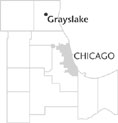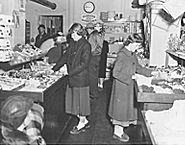| Entries |
| G |
|
Grayslake, IL
|
 Lake County, 38 miles NW of the Loop. As the massive Wisconsin glacier melted from the Grayslake area over 12,000 years ago, it left fertile land coveted by
Yankee
farmers, as well as numerous lakes and wet- lands, which made movement in the horse and wagon era difficult.
Lake County, 38 miles NW of the Loop. As the massive Wisconsin glacier melted from the Grayslake area over 12,000 years ago, it left fertile land coveted by
Yankee
farmers, as well as numerous lakes and wet- lands, which made movement in the horse and wagon era difficult.
In 1840, Massachusetts-born William M. Gray followed a difficult Indian trail from Chicago and settled at the southeast shore of an unnamed lake in western Lake County. Two year later Gray purchased his claim along with the area covered by the lake which became known as Gray's Lake. Other farmers trickled into the area in the mid- and late 1840s as a plank road extending from Waukegan to Belvidere (now Route 120) passed along the lake's south shore. Gray moved to Waukegan in 1845, where he engaged in mercantile activities.

|
As improved road construction following World War I allowed the use of increasingly reliable automobiles, adventurous drivers discovered the beauty of Grayslake. Through the 1920s, moderately well-to-do Chicagoans built spacious houses along the lake.
Typical of the experience of other communities in the area, cheap land prices and easy rail transportation to the city served as a magnet to soldiers returning from World War II who sought a less urban atmosphere to raise families. Chicagoans living mainly around Milwaukee Avenue in an area bounded by Fullerton and Cicero Avenues abandoned the city and found Grayslake a pleasant place to establish a suburban lifestyle. By 1950 the population had risen to 1,970.
In the late twentieth century, Grayslake officials embarked on an aggressive annexation policy. The community's boundaries now encompass the College of Lake County, originally built in what was once a rural area and itself a spur to suburban expansion. The village population more than doubled in the 1990s, rising to 18,506 in 2000.
| Grayslake, IL (inc. 1895) | |||||
| Year |
Total
(and by category) |
Foreign Born | Native with foreign parentage | Males per 100 females | |
| 1900 | 416 | — | — | — | |
| 1930 | 1,120 | 10.8% | 27.9% | 100 | |
| 1,120 | White (100.0%) | ||||
| 1960 | 3,762 | 3.4% | 15.2% | 100 | |
| 3,672 | White (97.6%) | ||||
| 1990 | 7,388 | 2.8% | — | 95 | |
| 7,281 | White (98.6%) | ||||
| 7 | American Indian (0.1%) | ||||
| 76 | Asian/Pacific Islander (1.0%) | ||||
| 24 | Other race (0.3%) | ||||
| 199 | Hispanic Origin* (2.7%) | ||||
| 2000 | 18,506 | 8.4% | — | 96 | |
| 16,840 | White alone (91.0%) | ||||
| 293 | Black or African American alone (1.6%) | ||||
| 35 | American Indian and Alaska Native alone (0.2%) | ||||
| 783 | Asian alone (4.2%) | ||||
| 6 | Native Hawaiian and Other Pacific Islander alone (0.0%) | ||||
| 314 | Some other race alone (1.7%) | ||||
| 235 | Two or more races (1.3%) | ||||
| 920 | Hispanic or Latino* (5.0%) | ||||
The Encyclopedia of Chicago © 2004 The Newberry Library. All Rights Reserved. Portions are copyrighted by other institutions and individuals. Additional information on copyright and permissions.